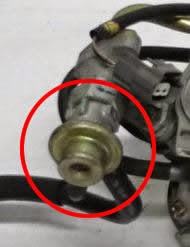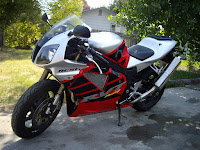2001 Honda RC51
Problem:
Poor mileage and poor performance. This motorcycle was spectacular in it's debut. I picked it up from a friend who hadn't ridden it in years. It sat in his garage, had been dropped and even rebuilt after a crash once. The issue with this motorcycle was poor performance, skipping throttle response, and running rich. At throttle, the bike would hesitate, as if it were running on a single cylinder instead of two.
Test Drive:
At highway speed the bike would move along, and then die, then kick on, die and then fire, die and then fire. It was a constant hiccup when driving down the road, that happened occasionally, but became worse over time. It was as if the engine governor would kick in even though you were nowhere near the redline. The engine would die, and then resume power repeatedly. Frustrating when you're on a trip between states, let me tell you!
Diagnosis:
At first I thought the problem was electrical, and so replaced one of the coil packs. This didn't resolve the issue. After some online research I saw some poor souls being ripped $2000 for a new fuel rail assembly, which did indeed cure their problems. The same problem I was having. However.... as a do it your selfer.... I find it hard to part with $2000 when the only components on the fuel rail consists of a few injectors, piping, and a fuel pressure regulator. It took me some time to bite the bullet to even think of parting with $2k just because some shop or even Honda recommends it. There had to be something else!
Fix:
Further troubleshooting..... gasoline is comprised of an ethanol mix these days, made of corn oil derivatives. Corn oil gets sticky when it's overheated, much like when you overheat corn oil in a frying pan. The design of the RC51 fuel system is that the fuel rail sits on top of the engine in a confined area, with poor air circulation. heat rises and slowly cooks that fuel pressure regulator after you've turn the key off and parked your bike. The residue buildup acts like plaque in your arteries as the residue clings to the interior of the fuel rail pipes and the fuel pressure regulator. Ever seen your lawn mower float bowl in the carburetor after it's been sitting over a winter? It's like that. Buildup of residue. Enough with the justification already,, lets move on....
The problem with the fuel rail assembly isn't with all of the components. Honda might suggest a new fuel rail assembly to save their technicians time in diagnosing the root cause. The problem as in my case, was with the fuel pressure regulator. The gasoline in the system had been sitting in the bike in this guys garage for two years or more. Internal residue is nearly impossible to get rid of or clean out of your fuel pressure regulator. Cost for a new regulator runs about $50.
Find and order one here..
HONDA REGULATOR, PRESSURE - order part here
1. Work on your bike when the engine has cooled off. Lift your fuel tank up.
 2. You might be able to access it without removing your air box. I recommend removing the air box to get full view of the fuel rail assembly. So... remove the air box.
2. You might be able to access it without removing your air box. I recommend removing the air box to get full view of the fuel rail assembly. So... remove the air box.3. Place a shop rag beneath the fuel pressure regulator. Hang some of the shop rag over the top of the fuel pressure regulator to catch any fuel spray as you remove the fuel pressure regulator. Use an open end box wrench to remove the fuel pressure regulator. Rotate the wrench counter-lock wise (righty-tighty, lefty-loosey) to loosen it. Unscrew the old one out with your hand.
4. Screw a new one into place. Do you need teflon tape? Not likely. Just reassemble with all components (washers etc...). Use new washers if you prefer, and, IF there is one. I can't remember, it's been awhile.
5. Tighten the new fuel pressure regulator into place with the wrench. Don't monster tighten it, but you do want it tight.
6. Key on, to test the fuel pressure in the system and check for leaks. With the tank up, and fuel lines connected, turn the key on, and pressure should build up. Look for any leaks at the fuel pressure regulator fitting. If there are none, cycle the key on/engine off several times to build up proper fuel pressure within the fuel rail. If no leaks occur, then you are good to go. It's tempting to start it up right now, and if you do, for goodness sake, remove all your tools, screws, bolts, loose components and shop rags from the intake path and throttle bodies so they don't get sucked in there and cause all sorts of horror.
7. Reassemble the air box, remove any other tools and rags. Lower your tank, button it up, and take your baby down the road for an obnoxious roar or two!
8. Check for leaks over the next few days or rides. You can never be too careful. The last thing you'd want is to ride down the road with your crotch on fire.
Post work assessment:
 Problem solved with the new fuel pressure regulator installed. previously my problem was sooooo bad I was getting 3mpg. No joke, it sucked! With the new regulator installed, everything was fine, fuel economy if you can call it that with this bike, had returned. No more skipping throttle response, no more dead throttle spots. Everything was great! And I saved $2000!
Problem solved with the new fuel pressure regulator installed. previously my problem was sooooo bad I was getting 3mpg. No joke, it sucked! With the new regulator installed, everything was fine, fuel economy if you can call it that with this bike, had returned. No more skipping throttle response, no more dead throttle spots. Everything was great! And I saved $2000!Hope this helps someone out there!

